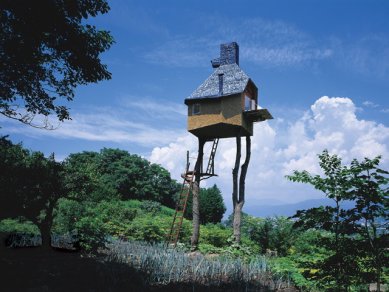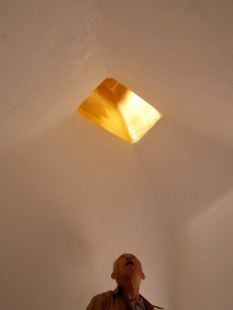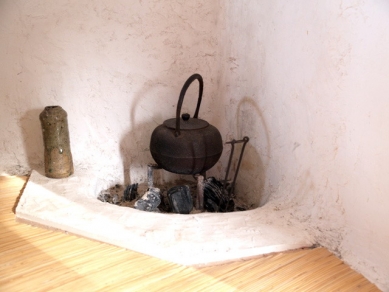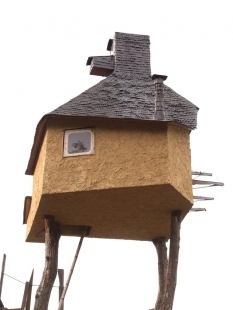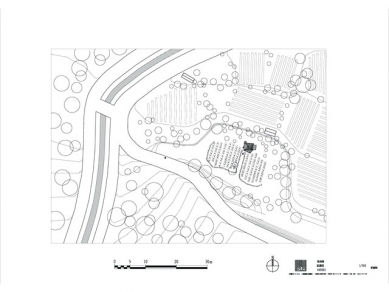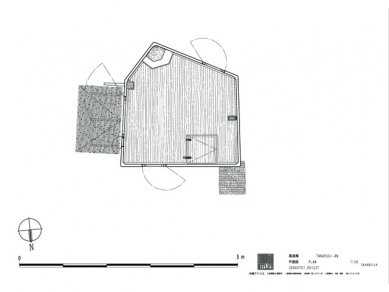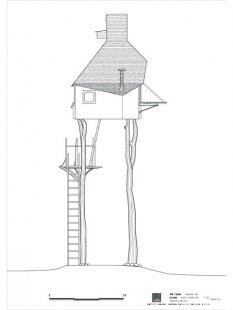
Takasugian – Too Tall Tea House

The view of the high mountains above Nagano and the sacred Kami of the surrounding landscape, the floor gently sways beneath our feet as the wind rustles around, lulling more than one guest after a delightful Matcha tea. Even today, the scent of this tea brings back the memory of the view from the seven-meter height of the Takasugian tea house.
The space for the traditional tea ceremony is a theme that continues to entice contemporary Japanese architects, as it presents a significant challenge. A tea house can be considered a "masterpiece" in traditional architecture, where the most refined materials are carefully chosen, and the cost per square meter often far exceeds that of a family home; the construction is entrusted to the most skilled craftsmen (daiku). It is unnecessary to elaborate on the rich history of the tea's journey; all information is readily available. I will only remind you that the "first" classical tea room in the proper sense was defined under the patronage of warlord Toyotomi Hideyoshi by the master Sen no Rikyū (1522-1591), known more commonly by his epithet Rikyū, in the 16th century. He established and elevated the tea ceremony to high perfection, including all related elements. Thus, Sen no Rikyū significantly influenced the foundations of traditional Japanese aesthetics. The space of the tea room, as defined by Rikyū, presents a theme and a question for contemporary architects on how to engage with his legacy. The thought that it could be surpassed should not even cross our minds, because, as Professor Fujimori says, no matter how hard we try, we will always arrive at a point that Sen no Rikyū has already discovered. The traditional tea room Sukiya represents nothing more than a mere "hut"; its original signs mean a refuge of thoughts, a refuge of emptiness, a refuge of irregularities that leaves space only for the objects that serve to soothe the aesthetic experience of the moment.
In the spring of 2007, together with five students of Professor Terunobu Fujimori, we visited his tea house Takasugian. At that time, there were a total of seven of us inside, and to our great surprise, the elderly father of architect Fujimori climbed up with us, above whose vegetable beds Takasugian rises seven meters high. And so, we probably tested its maximum static limits on the 5m² of internal space.
For Terunobu Fujimori's tea houses, it is characteristic that they are not created for orthodox followers of specific tea schools, but primarily for clients who love drinking tea and dedicate appropriate time to it. Fujimori seeks his own way to engage with the legacy of Sen no Rikyū, and Takasugian is genuinely perhaps the first tea house set among the branches of trees, which he selected from the local mountain forests and planted on the site in such a way as to create the impression that they have been there since time immemorial. Over the course of six months, a tea house literally grew on the trunks beneath the scaffolding, which has become one of Fujimori's most well-known buildings.
Takasugian is characterized by the use of traditional materials such as clay plaster and a shingled copper roof. The entrance to the tea house is located below, as one of the rules defined by Rikyū is the humility that one must express when entering the room – in a classical tea room, this involves passing through a very low portal (about 0.8 m), here it represents maximum humility. Inside, there is a hearth (Ro) and in the roof, there is Fujimori's favorite lantern inlaid with gold, which lets in outside light through one of the few openings. The internal atmosphere and the view of the landscape truly open the space for diverse thoughts and inner contemplation over a cup (Chawan) of delicious green tea.
After an hour of storytelling about Fujimori's rural childhood, we reluctantly left the tea heights back to the "worldly" ground. We carried a long ladder to a place about 250 meters away, from where it had to be brought, because visiting Takasugian represents a certain ritual with its specific rules. We hopped onto the hood of Fujimori's father's "safari car" and set off on the journey to the station, from where we returned to the bustle of evening Tokyo.
The space for the traditional tea ceremony is a theme that continues to entice contemporary Japanese architects, as it presents a significant challenge. A tea house can be considered a "masterpiece" in traditional architecture, where the most refined materials are carefully chosen, and the cost per square meter often far exceeds that of a family home; the construction is entrusted to the most skilled craftsmen (daiku). It is unnecessary to elaborate on the rich history of the tea's journey; all information is readily available. I will only remind you that the "first" classical tea room in the proper sense was defined under the patronage of warlord Toyotomi Hideyoshi by the master Sen no Rikyū (1522-1591), known more commonly by his epithet Rikyū, in the 16th century. He established and elevated the tea ceremony to high perfection, including all related elements. Thus, Sen no Rikyū significantly influenced the foundations of traditional Japanese aesthetics. The space of the tea room, as defined by Rikyū, presents a theme and a question for contemporary architects on how to engage with his legacy. The thought that it could be surpassed should not even cross our minds, because, as Professor Fujimori says, no matter how hard we try, we will always arrive at a point that Sen no Rikyū has already discovered. The traditional tea room Sukiya represents nothing more than a mere "hut"; its original signs mean a refuge of thoughts, a refuge of emptiness, a refuge of irregularities that leaves space only for the objects that serve to soothe the aesthetic experience of the moment.
In the spring of 2007, together with five students of Professor Terunobu Fujimori, we visited his tea house Takasugian. At that time, there were a total of seven of us inside, and to our great surprise, the elderly father of architect Fujimori climbed up with us, above whose vegetable beds Takasugian rises seven meters high. And so, we probably tested its maximum static limits on the 5m² of internal space.
For Terunobu Fujimori's tea houses, it is characteristic that they are not created for orthodox followers of specific tea schools, but primarily for clients who love drinking tea and dedicate appropriate time to it. Fujimori seeks his own way to engage with the legacy of Sen no Rikyū, and Takasugian is genuinely perhaps the first tea house set among the branches of trees, which he selected from the local mountain forests and planted on the site in such a way as to create the impression that they have been there since time immemorial. Over the course of six months, a tea house literally grew on the trunks beneath the scaffolding, which has become one of Fujimori's most well-known buildings.
Takasugian is characterized by the use of traditional materials such as clay plaster and a shingled copper roof. The entrance to the tea house is located below, as one of the rules defined by Rikyū is the humility that one must express when entering the room – in a classical tea room, this involves passing through a very low portal (about 0.8 m), here it represents maximum humility. Inside, there is a hearth (Ro) and in the roof, there is Fujimori's favorite lantern inlaid with gold, which lets in outside light through one of the few openings. The internal atmosphere and the view of the landscape truly open the space for diverse thoughts and inner contemplation over a cup (Chawan) of delicious green tea.
After an hour of storytelling about Fujimori's rural childhood, we reluctantly left the tea heights back to the "worldly" ground. We carried a long ladder to a place about 250 meters away, from where it had to be brought, because visiting Takasugian represents a certain ritual with its specific rules. We hopped onto the hood of Fujimori's father's "safari car" and set off on the journey to the station, from where we returned to the bustle of evening Tokyo.
The English translation is powered by AI tool. Switch to Czech to view the original text source.
6 comments
add comment
Subject
Author
Date
Ach, ten pravopis
May
02.05.08 02:13
zbyva jen doufat
Michal Just
08.05.08 06:06
sen no rikjů
Tomáš Cebula
14.05.08 09:12
ad "zbývá jen doufat"
Josef Čančík
15.05.08 08:25
...
Michal Just
18.05.08 11:54
show all comments


